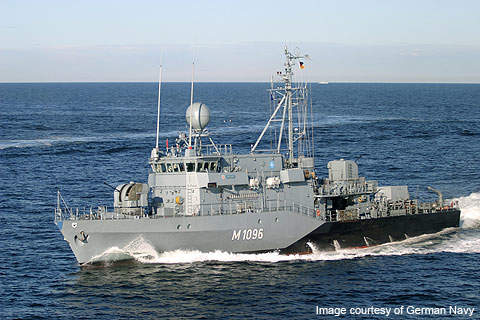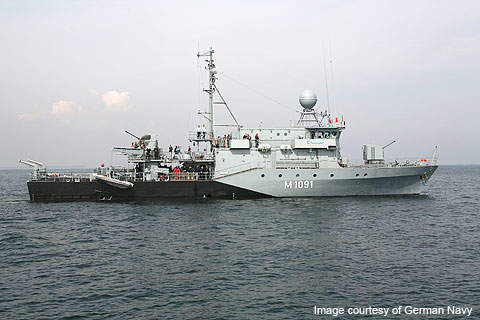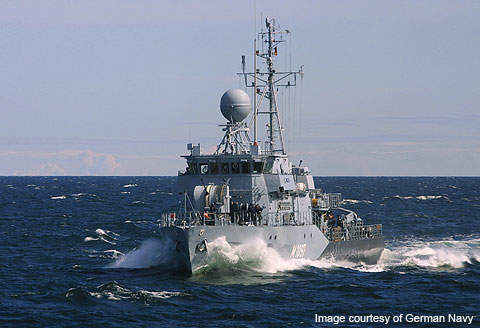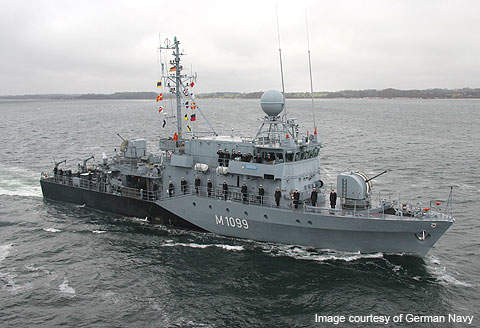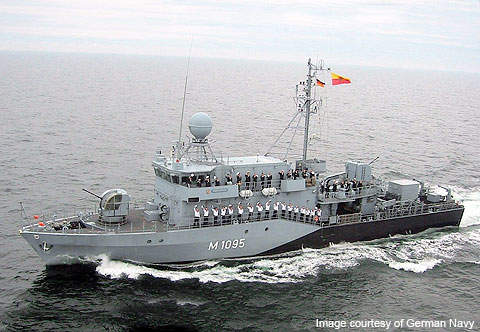The Kulmbach Class (MJ 333) minehunters are in service with the German Navy. Built as Hameln Class (SM 343) minesweepers by STN Systemtechnik Nord, five vessels were converted to Kulmbach Class between 1999 and 2001.
The vessels were not formally recommissioned after the upgrade. The keel for the Kulmbach (M1091) was laid down in September 1987. It was launched in June 1989 and commissioned in April 1990. The Überherrn (M1095) was laid down in December 1986, launched in August 1988 and commissioned in September 1989. The Passau (M1096) was laid down in July 1988, launched in March 1990 and commissioned in December 1990. The Laboe (M1097) was laid down in March 1987, launched in September 1988 and commissioned in December 1989. The Herten (M1099) was laid down in June 1988, launched in December 1989 and commissioned in February 1991. All units are operated by the 3rd Minesweeping Squadron based in Kiel at the Baltic Sea.
Kulmbach Class has an overall length of 54.4m, a width of 9.2m and a draft of 2.5m. The displacement of the vessel is 635t. The ship can accommodate a crew of 37, including four officers, 20 petty officers and 13 ratings.
Kulmbach Class design
The vessel’s hull is made of non-magnetisable steel, with the structure designed to lay, hunt and sweep mines. Noise levels from the hull are significantly reduced by installing the equipment on vibration-resilient mountings, and the engine is fitted on a concrete block to reduce vibration. The original design was slightly modified to incorporate modern equipment.
Mine countermeasures suite
Kulmbach Class minehunters are fitted with an underwater positioning system that locates and disposes ground and floating mines with the mine-hunting drone SeaFox. The drone features a short-range sonar and built-in video camera, which can accurately identify and automatically reach the mine. It also has a built-in explosive charge. The system effectively handles all types of mines and ignition mechanisms, and provides the vessel with an advanced mine-hunting and disposal capability.
SeaFox also integrates an automatic tracking system for the inspection and destruction of underwater mines. In addition to mine-hunting, the vessels can lay a larger number of mines.
Kulmbach Class vessels can easily integrate into the overall network of the fleet due to their location representation and tracking resources.
Kulmbach Class missiles
The minehunter is armed with two, four-cell Stinger missile launchers firing FIM-92 Stinger surface-to-air missiles. The missile provides short-range defence against low-flying aircraft. Developed by Hughes (now Raytheon), the missile is manufactured by EADS.
Naval guns
Kulmbach Class vessels were initially fitted with two Bofors 40mm/L70 dual-purpose guns. The Bofors guns were later replaced with Rheinmetall MLG 27 remote-controlled guns. The MLG 27 can fire at a rate of 1,700 rounds a minute.
Countermeasures, sensors and radars
The vessel is fitted with a DR 2000 radar warning receiver developed by Thales. The ESM (electronic support measure) receivers are capable of detecting pulse and continuous wave radars.
Two MASS (multi ammunition softkill system) decoy launchers are installed for chaff decoy. The MASS is a naval self-defence system developed by Rheinmetall. The system deceives incoming sensor-guided missiles by launching decoys.
The minehunters are equipped with a hull-mounted retractable DSQS-11 mine-detection sonar.
Developed by Atlas Elektronik, DSQS-11 uses pulse compression and other advanced signal processing methods to detect, classify and track mines and mine-like targets. The operator can use side-scan mode for route surveys.
The radars include a WM-20/2 track-while-scan surface search radar and a Raytheon SPS-64 I-band navigation radar.
Propulsion
The ship is powered by two MTU 16V 396 TB84-DB5IL diesel engines. Each engine, providing 2,240kW, drives two variable pitch propellers through two shafts. The engines provide a maximum speed of 18kt. The onboard power is generated by three MWM TBD diesel generators producing an output of 1,050kW.

